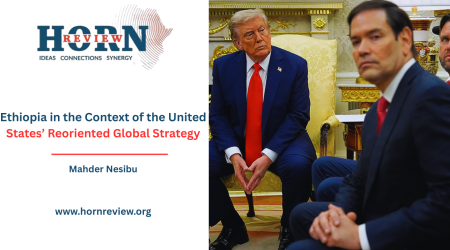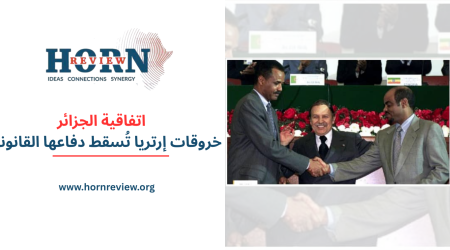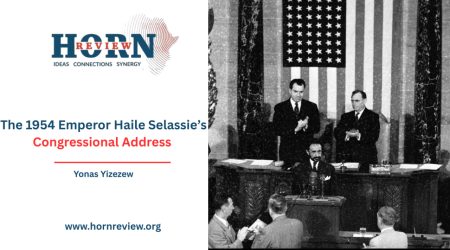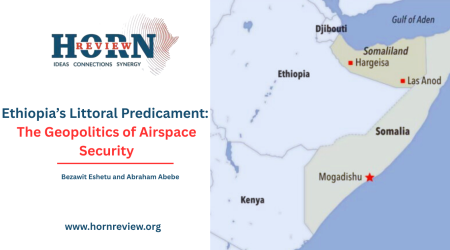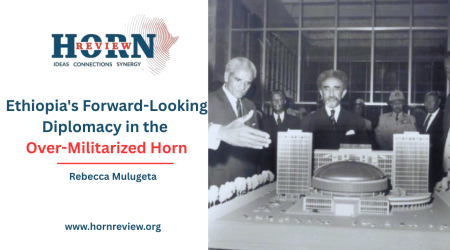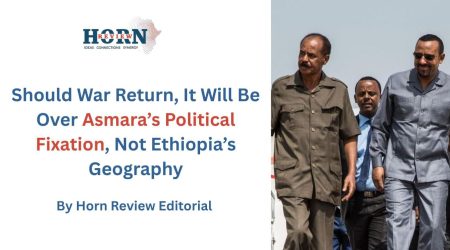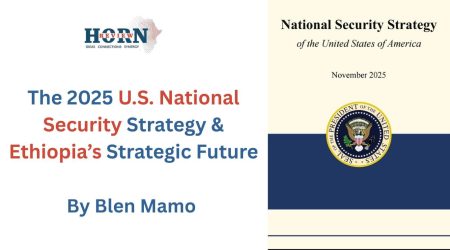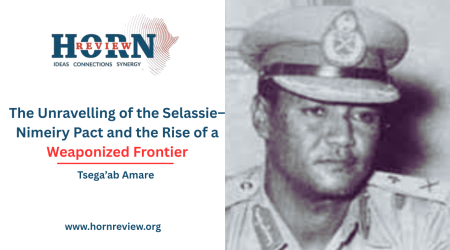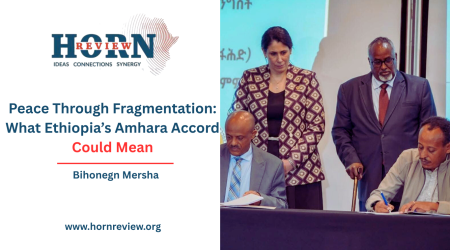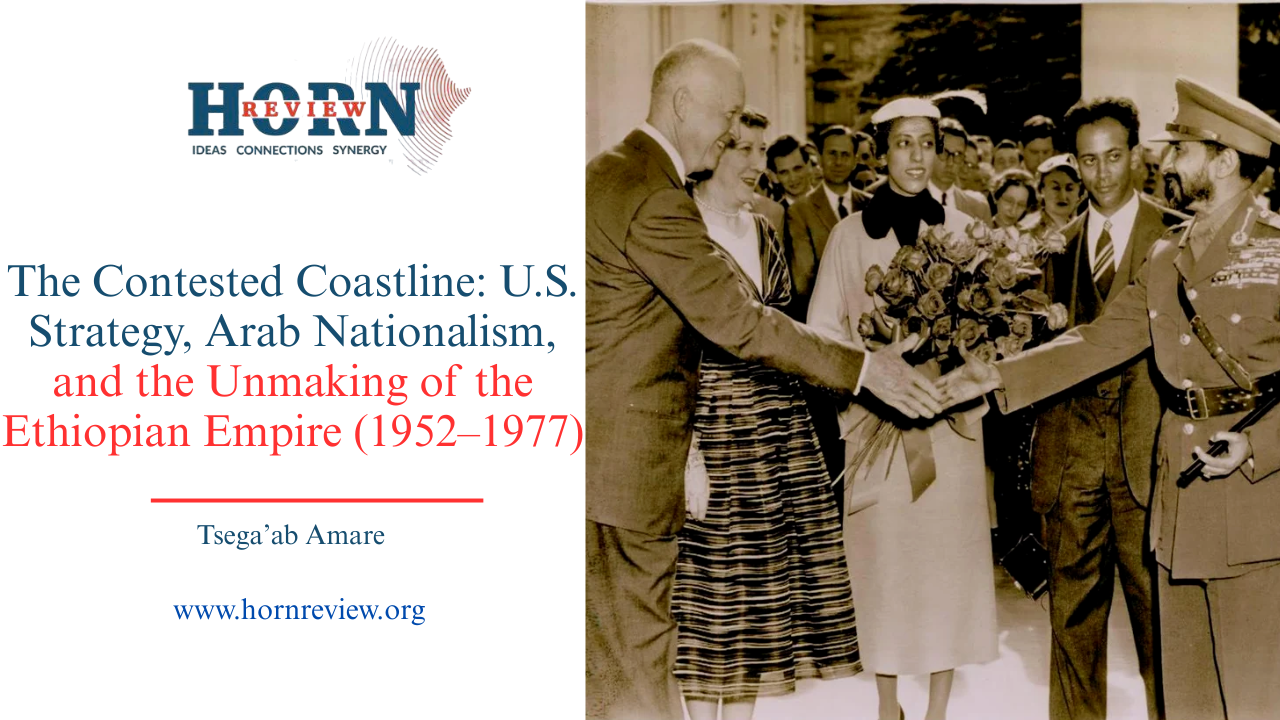
27
Oct
The Contested Coastline: U.S. Strategy, Arab Nationalism, and the Unmaking of the Ethiopian Empire (1952–1977)
The geopolitical history of the Red Sea basin during the Cold War was shaped by a complex mix of strategic competition, ideological rivalry, and economic ambition. From the 1950s onward, the United States anchored its strategic containment in the Horn of Africa through a critical alliance with Imperial Ethiopia under Emperor Haile Selassie.
What first started as a pragmatic security arrangement later evolved into a geopolitical fault line that linked the fate of the Ethiopian empire to the shifting balance of power between the U.S., Egypt, and the broader Arab world. The legacy of these Cold War bargains continues to shape Ethiopia’s maritime ambition and regional diplomacy today.
The footing for American presence in Northeast Africa came to life under the 1953 U.S.– Ethiopian Mutual Defense Assistance Agreement (MDAA). For Washington, the Priority was to secure a dependable foothold in a region that serves as a bridge between the Middle East and sub-Saharan Africa. The primary asset secured by the US was the highly complex communications and intelligence facility known as Kagnew Station, situated in the Eritrean capital, Asmara, with a lease secured for 25 years. In contrast, for Haile Selassie’s Ethiopia, this alliance offered military modernization and political protection in a volatile neighborhood.
The arrangement was clear. Ethiopia received training and equipment through the U.S. Military Assistance Advisory Group. This unit helped Ethiopia build “black Africa’s first modern army” consisting of three divisions of 6,000 men each. Meanwhile, the United States gained secure access to Eritrea’s highlands and its Red Sea coastline. The emperor used this partnership to strengthen his armed forces and consolidate control over its contested territories.
However, as the Kagnew Station’s sustainability depended entirely on Massawa, the nearby Red Sea port that serves as its logistical gateway, the U.S. was given full port visiting rights and storage facilities, transforming Massawa into the backbone of America’s Cold War presence in the Horn.
This exchange was not a one-time transaction but a structured geopolitical bargain. In return for hosting strategic American installations, Haile Selassie gained leverage to pursue his two main foreign policy objectives: full control over the Ogaden region and the integration of Eritrea. U.S. diplomatic and military backing gave Ethiopia the strength to secure these ambitions and the confidence to challenge both colonial legacies and regional rivals.
The emperor’s strategy was rooted in postwar frustration with British dominance. After the defeat of Italy in 1941, Britain established the Occupied Enemy Territory Administration and retained control over key territories, including the Ogaden and the Haud. Even after sovereignty was formally restored, British officers maintained authority in these regions, limiting Ethiopia’s freedom of action. Haile Selassie sought to replace British oversight with a new, dependable ally that could guarantee Ethiopia’s borders and strengthen his internal authority.
In negotiations with the British in 1944, Ethiopia explicitly invoked the United States as a neutral arbiter, suggesting that military arrangements in the Ogaden would only continue if Washington deemed them necessary. This was a calculated diplomatic move designed to position the United States as the guarantor of Ethiopia’s postwar settlement. By the early 1950s, with Cold War tensions deepening, Haile Selassie succeeded in aligning Ethiopia’s sovereignty with America’s global containment strategy.
This military backing provided the necessary strength to maintain garrisons and supply routes in the contested Ogaden region. Furthermore, US diplomatic support reinforced Ethiopia’s claim, as Washington publicly announced its opposition to any activities threatening Ethiopia’s territorial integrity. By 1964, Ethiopian forces, armed with U.S. equipment, had successfully defended the Ogaden in the border war with Somalia. Haile Selassie’s growing military capacity also gave him diplomatic prestige at the founding of the Organization of African Unity, where he championed the sanctity of colonial borders to upkeep Ethiopia’s territorial claims.
The U.S.–Ethiopian alliance created three interlocking conflicts that reshaped the Horn of Africa. First, American military support strengthened Haile Selassie to dissolve Eritrea’s federal autonomy, culminating in its annexation in 1962. Second, the presence of U.S. installations along the Red Sea turned Eritrea into a symbolic and strategic target for Arab nationalist movements led by Egypt’s Gamal Abdel Nasser. Third, Ethiopia’s use of American aid to fortify its eastern frontier deepened the Ogaden dispute with Somalia, which later became a flashpoint in Cold War rivalries.
This triangular dynamic meant that local disputes were no longer local and made the Horn a Cold War frontier, where global and regional powers projected their rivalries through proxies and alliances. Ethiopia’s imperial consolidation was now inseparable from Washington’s containment strategy and from Cairo’s broader struggle against Western influence. Haile Selassie proved an astute strategist, leveraging global rivalries to reinforce Ethiopia’s sovereignty and positioning himself as a deft negotiator capable of aligning national survival with superpower interests.
Beyond military interests, the U.S. presence in Eritrea was closely tied to corporate ambition. In the 1950s and 1960s, major American oil companies such as Mobil and Sinclair obtained exploration permits along the Eritrean coast. Geological surveys suggested that the Red Sea basin might be an extension of the Arabian oil province, and in 1969, Mobil’s offshore drilling confirmed significant gas and condensate potential. The fusion of military protection and corporate access created the perception of an American monopoly over Red Sea resources.
For the United States, the region’s value extended beyond oil. It offered control over one of the world’s most critical maritime routes, the Bab al-Mandab Strait, linking the Indian Ocean to the Mediterranean. Securing Massawa and Kagnew thus meant securing a position that connected U.S. power from the Gulf to East Africa. For Arab leaders, however, this consolidation of military and commercial power represented a direct challenge to their regional autonomy and economic leverage.
The Arab Counter-Strategy: Secession as Containment
Egypt’s response under Nasser was immediate and ideological. The U.S.–Ethiopian alliance was framed as a Western intrusion designed to isolate the Arab world and protect Western access to oil. Eritrea, with its Red Sea coastline and cultural ties to the Arab world, became the ideal theater for counteraction. Through Sawt al-Arab, Egypt’s powerful state radio, Nasser projected the Eritrean struggle as part of the broader Arab resistance to Western domination.
Arab states soon provided political, financial, and military support to Eritrean liberation movements. Egypt, Sudan, Syria, and later Saudi Arabia backed the Eritrean Liberation Front, and later the Eritrean People’s Liberation Front, supplying arms and diplomatic recognition. Their goal was clear: remove the U.S. military presence, weaken Ethiopia’s pro-Western alignment, and install a sympathetic independent state along the Red Sea. This would both neutralize American influence and ensure greater Arab control over the Bab al-Mandab chokepoint.
For Nasser and his allies, supporting Eritrean secession was not only an act of solidarity but a strategic instrument. It countered Ethiopia’s growing role in Nile politics, limited its influence in the Red Sea, and disrupted U.S. efforts to combine military containment with resource control. Pan-Arab solidarity thus converged with real geopolitical calculus. The success of the Eritrean struggle would mean a landlocked Ethiopia and the end of American bases along the coast.
The Reversal of the Transaction
By the early 1970s, the alliance that had sustained Ethiopia’s imperial reach was beginning to collapse. Economic discontent, student movements, and military unrest undermined Haile Selassie’s authority. In 1974, the Derg seized power, overthrowing the monarchy and aligning Ethiopia with the Soviet Union. The revolution reversed two decades of U.S.–Ethiopian cooperation. In 1977, the new regime abrogated the defense agreement, expelled U.S. personnel, and closed Kagnew Station, ending the American military presence in the Horn.
This shift marked not only the fall of an emperor but the unraveling of the entire Cold War architecture built on the Red Sea coast. The Soviet Union quickly replaced the United States as Ethiopia’s military patron, transforming the country into a key socialist ally in Africa. Yet even with Soviet backing, Ethiopia could not hold onto its empire. The Eritrean People’s Liberation Front captured Massawa in 1990 and achieved independence in 1993, fulfilling the long-term objective of the Arab states that had supported the secessionist cause.
The U.S.–Ethiopian entente that began as a strategic partnership for security and modernization ended as a cautionary tale of geopolitical overreach. The same ports and bases that once symbolized Ethiopia’s sovereignty became the entry points for competing foreign interests. Haile Selassie’s effort to balance sovereignty with strategic dependency ultimately produced the opposite result: the fragmentation of the state he sought to consolidate.
The Cold War transactions of the 1950s and 1960s, using security for access and aid for alignment, reshaped the Horn of Africa’s political geography. They turned Eritrea into a battleground of ideology and energy, made Ethiopia the pivot of superpower rivalry, and invited Arab intervention that redrew the map of the Red Sea. When Eritrea finally gained independence, the long arc of this struggle came full circle. The Red Sea coast that once secured Ethiopia’s place in the Western alliance became the line that permanently separated it from the sea.
Even today, the echoes of that contested coastline endure. Ethiopia’s interest in maritime access, regional security, and Red Sea diplomacy reflects a historical continuity rooted in those Cold War bargains. The struggle for the coast, once framed by empire and ideology, now returns under new terms.
But the strategic lessons remain unchanged. Stake on the Red Sea has always been more than a question of geography. It has been the measure of sovereignty, power, and survival in a region where global ambitions and local destinies are forever intertwined.
By Tsega’ab Amare, Researcher, Horn Review

